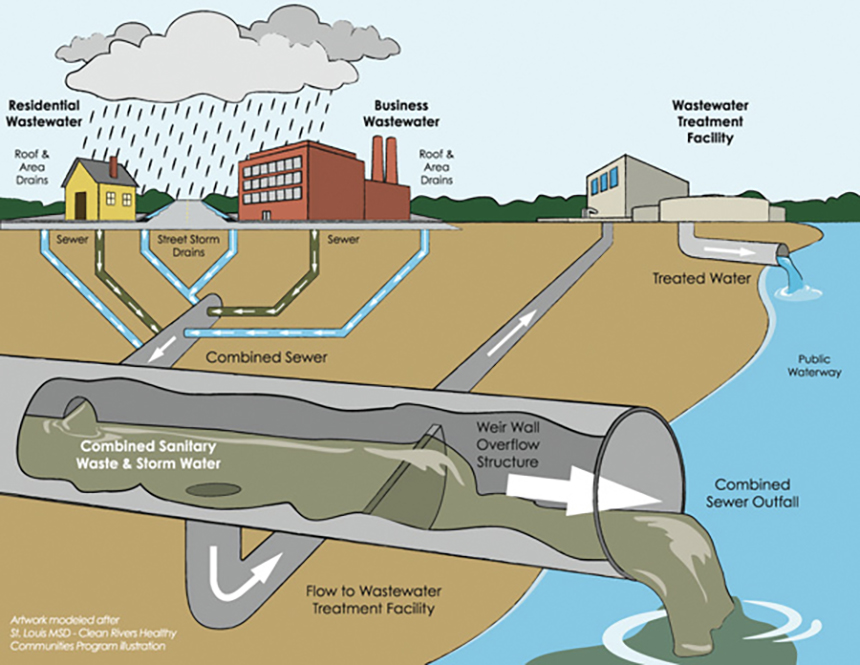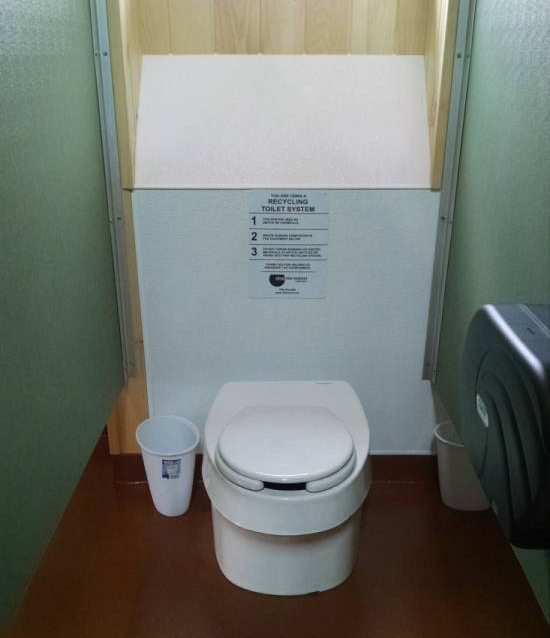By FRANK CARINI/ecoRI
News staff


The use of sewer, highlighted above, and septic systems to deal with human waste generate pollution and wastewater. Septic systems leak waste into groundwater, which can contaminate onsite drinking-water wells or other nearby wells. (Moss Design)
Today’s composting
toilets are not the equivalent of a port-a-potty stashed away in the basement.
In fact, some models look similar to everyday commodes, but they all save water
for drinking and showering.
And they don’t stink, require chemicals to clean, or flush or discharge human waste into the natural environment.
And they don’t stink, require chemicals to clean, or flush or discharge human waste into the natural environment.
The average
single-family home in the United States uses about 88,000 gallons of water
annually, according to a 2016 study. Some 24
percent of the daily usage, or about 30 gallons, is flushed down the toilet.
Despite federal regulations requiring that toilets use only 1.6 gallons of water per flush, toilets made before 1992 may be using up to 7 gallons a flush.
Even with the reduced 1.6-gallon standard, however, a single toilet flushed five times a day will waste nearly 2,340 gallons of potable water annually.
“Unfortunately we don’t
price or value water the way we should,” said Conor Lally, an ecological
sanitation planner and installer with a background in watershed science and
ecological design.
“Composting toilets just make more sense because you are not creating that wastewater to begin with. It’s a better way of managing that material.”
“Composting toilets just make more sense because you are not creating that wastewater to begin with. It’s a better way of managing that material.”
The Providence resident
and New York native co-founded Nutrient Networks to
focus on “root cause solutions to the economic and environmental problems
associated with conventional water, wastewater, and food systems.”
Those behind this fairly
new endeavor, including co-founder Danilo Morales and composting toilet guru
and vermicomposter Ben Goldberg, design, build, and install
composting and management systems that divert valuable nutrients from the waste
stream, reduce pollution, and help close the food-nutrient cycle.
They believe such
efforts play a critical role in the larger movement toward localizing energy,
water, and food, building soils, and improving public health.
Treating human waste
with septic systems and wastewater treatment plants is costly in both energy
and resources, contributes to soil and water pollution, contaminates
drinking-water supplies, and leads to combined sewage overflows into important
water bodies.
As the human population
continues to increase — 7.6 billion and counting — planners and
public-health professionals are beginning to recognize the need for
environmentally sound human waste treatment and recycling methods.
The notion of converting human waste to a usable resource, however, isn’t a new concept.
The notion of converting human waste to a usable resource, however, isn’t a new concept.
Wasting a resource
Lally’s first job out of college — he graduated from Boston University with a master’s degree in energy and environmental analysis — was working for John Todd Ecological Design doing constructive wetlands for wastewater treatment in Woods Hole on Cape Cod. His interest soon shifted to dry sanitation and composting toilets. He began working with Goldberg.
Lally’s first job out of college — he graduated from Boston University with a master’s degree in energy and environmental analysis — was working for John Todd Ecological Design doing constructive wetlands for wastewater treatment in Woods Hole on Cape Cod. His interest soon shifted to dry sanitation and composting toilets. He began working with Goldberg.
Lally said Todd’s
ecologically designed wastewater treatment systems still have a place, “but
what we started to realize was it was a smarter way of doing a stupid thing,
because at the end of the day we were still facilitating people pooping in
their drinking water.”
“It was a sexier way of
cleaning it up, but at the basis of it still was maybe not the best option, so
I became more interested in not creating the problem to begin with,” he
continued. “I think that’s what composting toilets and ecological sanitation is
all about.”
 |
| A composting toilet at Crane Beach in Ipswich, Mass. (Clivus New England) |
Originally
commercialized in Sweden, composting toilets have been an established
technology for more than three decades, but there’s still plenty of hesitation
when it comes to installing one in a home or making them part of 21st-century
building codes.
In fact, one of the major obstacles holding back composting toilet use in the United States are regulations geared toward flush systems and their waste of water.
In fact, one of the major obstacles holding back composting toilet use in the United States are regulations geared toward flush systems and their waste of water.
Composting toilet
systems — sometimes called biological toilets, dry toilets, or waterless toilets
— contain and control the composting of human waste and toilet paper.
And, unlike a septic system, composting toilets rely on aerobic bacteria to break down wastes, just as they do in a backyard compost pile.
And, unlike a septic system, composting toilets rely on aerobic bacteria to break down wastes, just as they do in a backyard compost pile.
Lally said the next step
for ecological sanitation is taking it to the watershed scale or community
scale to have a broader positive impact on the environment, most notably on
water bodies.
“That hasn’t necessarily
happened yet, but that’s what we are hoping to do,” he said. “To kind of make
the next jump with all of this.”
Nutrient Networks
travels across New England installing residential composting toilets and
designing and building more complex wastewater systems.
The company, for instance, has installed two composting toilets at the Listening Tree Cooperative in Chepachet, R.I., and seven at Round the Bend Farm in South Dartmouth, Mass.
The company, for instance, has installed two composting toilets at the Listening Tree Cooperative in Chepachet, R.I., and seven at Round the Bend Farm in South Dartmouth, Mass.
Lally has also traveled
to New Zealand and the Grand Canyon to work on ecological sanitation projects.
The state of Rhode
Island installed its first composting toilet during a major renovation of the
Misquamicut State beach pavilion in the 1990s. Today, there are more than 20 composting
toilets at state parks, beaches, and campgrounds.
Shoveling humanure
Composting toilets only treat human waste, so a separate wastewater system, either a septic tank or sewer hookup, is needed to handle dish washing, laundry, and bathing.
Composting toilets only treat human waste, so a separate wastewater system, either a septic tank or sewer hookup, is needed to handle dish washing, laundry, and bathing.
Composting toilets can
be retrofitted into an existing bathroom or incorporated into new construction.
They come in many shapes and sizes depending upon the number of users. They can
be homemade, custom-built, or manufactured.
The way they work isn’t
“dissimilar from your backyard composting,” Lally said. “It relies on the same
science, but there is the element of potential pathogens that has to be taken
seriously. But with enough retention time it can produce a very safe,
nutrient-rich compost that can be worked back into the soil rather than flushed
out into our water bodies.”
He said maintenance of
most systems isn’t difficult or time consuming, but “very important to do.”
The most important thing
when selecting a composting toilet is to choose a system that adequately meets
your home or business needs, according to Goldberg, who has been installing
composting toilet systems in private residences, businesses, and public
facilities across New England since the 1980s.
Lally noted model and
system choices come down to preferences.
“There’s a lot of
different systems out there so someone might be more interested in being more
engaged and want to actually have a very simple bucket-style system where they
are more frequently bringing a bucket of humanure out to a secondary compost
site,” he said. “Other people might not have any interest in having that level
of involvement in managing their own humanure.”
He said some of
the more advanced, large-capacity systems such
as the Phoenix and Clivus Multrum have very simple maintenance tasks and
everything happens within a basement tank. Regular management of most
composting toilet systems requires adding carbon-based bulking material such as
pine shavings or saw dust.
“I think it’s good for
people to be a little bit more aware and engaged in how humanure can be
managed,” Lally said. “We see it as a resource not as a waste.”